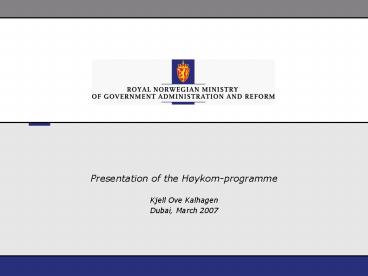Presentation of the Hykomprogramme - PowerPoint PPT Presentation
1 / 11
Title:
Presentation of the Hykomprogramme
Description:
Conversion (from traditional telephony) to IP telephony in a municipality or region. Inter-municipal collaboration (IT-services and IT-based services) ... – PowerPoint PPT presentation
Number of Views:40
Avg rating:3.0/5.0
Title: Presentation of the Hykomprogramme
1
Presentation of the Høykom-programme
- Kjell Ove Kalhagen
- Dubai, March 2007
2
The Høykom-programme
- A programme funded by the Ministry of Government
Administration and Reform - Stimulate the development and dissemination of
innovative broadband based eGovernment
applications - Supports projects at both local, regional and
central level - Conversion (from traditional telephony) to IP
telephony in a municipality or region - Inter-municipal collaboration (IT-services and
IT-based services) - Establishment of digital learning resources and
learning arenas in the education system - Making public services available through portal
projects. - Streamlining service provision through the
digitalisation of entire value chains - Streamlining service provision through
telemedicine/remote diagnostics and remote
consultation in the health-sector
3
Portfolio of projects
Supported over 400 different projects since
1999 Contributed to launch or upgrade of
broadband in a large number of public
institutions in many sectors Contributed to new
and improved services to the public as well as
more efficient internal administration
4
Background measurement framework
- Office of the Audtior General of Norway (2004)
- Lots of IT-projects have been initiated, but
little focus on how to secure benefits - Lack of skills in agencies and municipalities
related to technical and organisational aspects - OECD eGovernment peer review of Norway (2005)
- Lack of capacity and capabilities for ICT
project/management at agency level - Lack of general framework for analysing and
monotoring economic impacts of eGovernment
projects
5
Benefit realisation framework
- With effect from 2005 projects that receive
support must report on a set of established
quantitative and qualitative indicators - Why measure?
- To better understand the economic impact of
ICT-projects (quantitative and qualitative) - Identify possible legal, organisational or
technical obstacles to realising the potential
benefits of eGovernment - Establish best practice projects that may serve
as models or lighthouses for other projects
6
(No Transcript)
7
(No Transcript)
8
First results
- The firs results includes the short run effects
of ICT-implementation - Higher benefits expected in the long run when new
ways of working have resulted in organisational
changes - 3 municipalities collaborating on the basis of
shared IT systems (wages, accounts etc.) 800 000
NOK (100 000 ) in reduced operating expenses per
year - Introduction of e-application of building
permissions in 7 municipalities - Cost 3,6 Mill NOK (implementation cost)
- Savings 9 Mill NOK Pbl / 4 Mill Nok Prv. (yearly)
- Cooperation via GIS between Government and
private actors with regard to carthograpic data
for cables in Oslo - Cost 19,5 Mill NOK
- Savings 13Mill NOK (yearly)
9
Cost benefit analysis of Mobile x-ray in
Norwegian nursing homes
- In Western European countries, the elderly
population is set to grow dramatically by 2015,
with a particular large increase in the number of
people over 85 years. - More resources, including radiology services will
therefore be required - We have about 36 000 nursing home-beds three
times the number of all of Norways somatic
hospital beds combined - The Oslo region has one of the highest hip
fracture rates in the world.
10
Mobiel x-ray pilot in Oslo
- Started in September 2004 6 nursing homes
- Present
- gt 800 patients from 46 nursing homes
- gt 1000 examinations
- Since start up more than 800 x-rays pictures (3,2
in average per day) - 76 female 24 male
- Average age 87 years
The eguipment
Pictures sent from NH to hospitals via broadband
lines
11
Results from pilot
Previously Mobile x-ray
- Two ambulance transports 4 persons
- 1 aide from NH
- 1-2 Radiographer
- 1 radiographer
- (1 aide from NH)
Saves the community approximately NOK 3200 (400)
per examination. 30 of current costs saved to
traditional x-rays, if one patient per stop is
served. Savings rise to 60 if two patients are
served. Qualitative benefits for user - gt
Traditional x-rays is time consuming for patients
(5 hours on average related to transportation and
waiting.)































